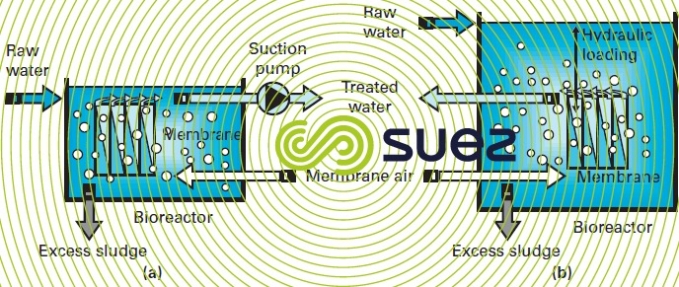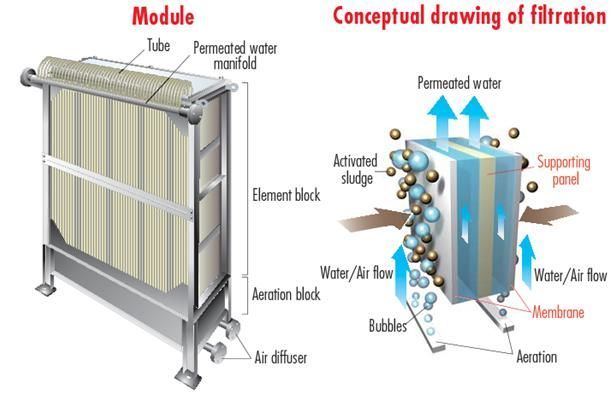How Membrane Bioreactor Can Improve the Quality of Wastewater Treatment
Wiki Article
Recognizing Membrane Bioreactors: The Future of Wastewater Treatment
Membrane bioreactors (MBRs) stand for a noteworthy technology in the field of wastewater therapy, incorporating biological processes with advanced membrane filtration to improve effluent quality. As worldwide water scarcity and rigid regulative frameworks come to be progressively pressing problems, MBR modern technology offers a reliable action with its ability to reduce footprint and optimize resource healing. Nevertheless, the adoption of MBRs is not without its difficulties, which merit mindful consideration. What are the crucial aspects influencing their implementation and long-lasting practicality in different contexts? The solutions may reshape our approach to wastewater administration.What Are Membrane Bioreactors?

The core elements of MBR systems consist of a bioreactor where microbial activity takes place and a membrane unit that filterings system the combined alcohol. This dual performance allows the synchronised deterioration of raw material and solid-liquid separation in a solitary step. MBRs can run in both submerged and external configurations, with submerged systems being a lot more usual due to their small layout and operational efficiency.
The fostering of MBR innovation has actually acquired traction in various applications, varying from metropolitan wastewater therapy to commercial effluent administration. MBRs are particularly beneficial in scenarios where room is stringent or limited effluent quality standards must be met. By maintaining a high concentration of microbes within the bioreactor, MBRs boost the degradation of natural pollutants, therefore producing greater therapy performances contrasted to traditional techniques.
Trick Benefits of MBR Technology
The assimilation of organic therapy with membrane purification in MBR systems provides various benefits that set it aside from traditional wastewater treatment techniques. Among the main benefits is the enhanced effluent top quality. MBRs properly eliminate put on hold solids and microorganisms, attaining higher degrees of purification that fulfill strict discharge criteria and promote water reuse applications.
One more significant advantage is the lowered sludge production. MBR systems create much less excess sludge, resulting in lower disposal costs and a decrease in ecological effect. The shut nature of the membrane layer system decreases the risk of smell exhausts and boosts total process control.
Lastly, MBRs are versatile and versatile, making them suitable for different wastewater kinds, consisting of industrial and metropolitan sources. The ability to incorporate with advanced therapy modern technologies additionally improves their effectiveness, making MBRs an encouraging remedy for the future of wastewater administration.
Difficulties and Limitations of MBRs
While MBR modern technology offers many advantages, it additionally faces several challenges and constraints that can impact its prevalent fostering. One significant obstacle is the i was reading this high resources and functional costs connected with MBR systems. The preliminary investment for membrane layer materials and the necessary facilities can be significant, making it much less accessible for smaller municipalities or industries.Furthermore, membrane fouling continues to be a critical concern that can diminish system efficiency and rise upkeep demands. Fouling takes place when solids, raw material, or microorganisms gather on the membrane surface, bring about minimized permeability and needing constant cleansing or substitute.
Another restriction entails the complexity of the modern technology. MBR systems require skilled employees for procedure and maintenance, which can be an obstacle in regions with limited technical experience. The disposal of invested membrane layers offers ecological concerns, as the products are usually not naturally degradable and can add to lose administration difficulties.
Lastly, while MBRs can successfully treat a wide variety of wastewater, they might not appropriate for all applications, specifically those with high focus of fats, oils, and greases, necessitating additional research and technology to deal with these limitations.
Applications of Membrane Layer Bioreactors
In different fields, membrane layer bioreactors (MBRs) have actually arised as a versatile solution for wastewater therapy (Membrane Bioreactor). Their applications extend local, industrial, and farming settings, showcasing their flexibility and performance in varied atmospheres. In municipal wastewater therapy plants, MBRs Discover More Here dramatically enhance effluent high quality, permitting water reuse and reducing the ecological effect of discharged wastewaterIndustrially, MBRs are used in food and drink processing, fabric production, and pharmaceutical production, where they efficiently deal with high-strength waste streams. Their ability to take care of varying tons and differing pollutant concentrations makes them specifically useful in these fields. In addition, MBRs help with the elimination of pathogens, suspended solids, and raw material, contributing to conformity with strict discharge regulations.
In agriculture, MBRs are increasingly utilized for dealing with farming runoff and animals wastewater, enabling the recuperation of nutrients for fertilizer production. They additionally help in the treatment of greywater for watering, promoting sustainable water monitoring techniques.
The adaptability of MBRs is additional shown by their integration with various other technologies, such as anaerobic food digestion and advanced oxidation processes, boosting total performance and resource recovery in wastewater therapy systems.
The Future of Wastewater Therapy
Developments in technology and a growing emphasis on sustainability are forming the future of wastewater therapy. Membrane layer bioreactors (MBRs) exemplify this shift by incorporating organic treatment processes with membrane layer purification, leading to high-grade effluent suitable for reuse. The fad towards circular economic climates is motivating centers to adopt MBRs for their capacity to recoup sources, such as water and nutrients, from wastewater.Developments in membrane layer products and setup are boosting the efficiency and longevity of MBR systems, reducing operational costs and power usage. Smart innovation integration, including real-time monitoring and automated control systems, is more enhancing efficiency and making it possible for predictive upkeep, therefore minimizing downtime.
Furthermore, governing pressures and social expectations are pressing towns and industries to take on even more lasting methods. Membrane Bioreactor. The shift in the direction of decentralized wastewater therapy options is gaining grip, enabling for local treatment that minimizes transport expenses and energy use
Conclusion
Membrane layer bioreactors (MBRs) represent a transformative method to wastewater therapy, integrating biological processes with advanced membrane modern technology. The benefits of MBRs, consisting of enhanced effluent high quality, decreased spatial demands, and reduced sludge production, place them as a practical remedy in the middle of growing urbanization and more stringent ecological guidelines. Despite existing challenges, the look here ongoing development in membrane layer products and operational strategies promises to strengthen the efficiency and fostering of MBRs, ensuring their essential function in the future of lasting wastewater management.Membrane bioreactors (MBRs) stand for a significant advancement in the field of wastewater therapy, integrating biological processes with sophisticated membrane filtering to improve effluent high quality.Membrane bioreactors (MBRs) combine biological therapy procedures with membrane purification to properly treat wastewater.The assimilation of organic therapy with membrane filtration in MBR systems supplies many benefits that set it apart from standard wastewater treatment methods. Membrane bioreactors (MBRs) exemplify this change by integrating biological therapy procedures with membrane purification, resulting in top quality effluent ideal for reuse.Membrane layer bioreactors (MBRs) stand for a transformative technique to wastewater treatment, incorporating organic procedures with sophisticated membrane layer modern technology.
Report this wiki page